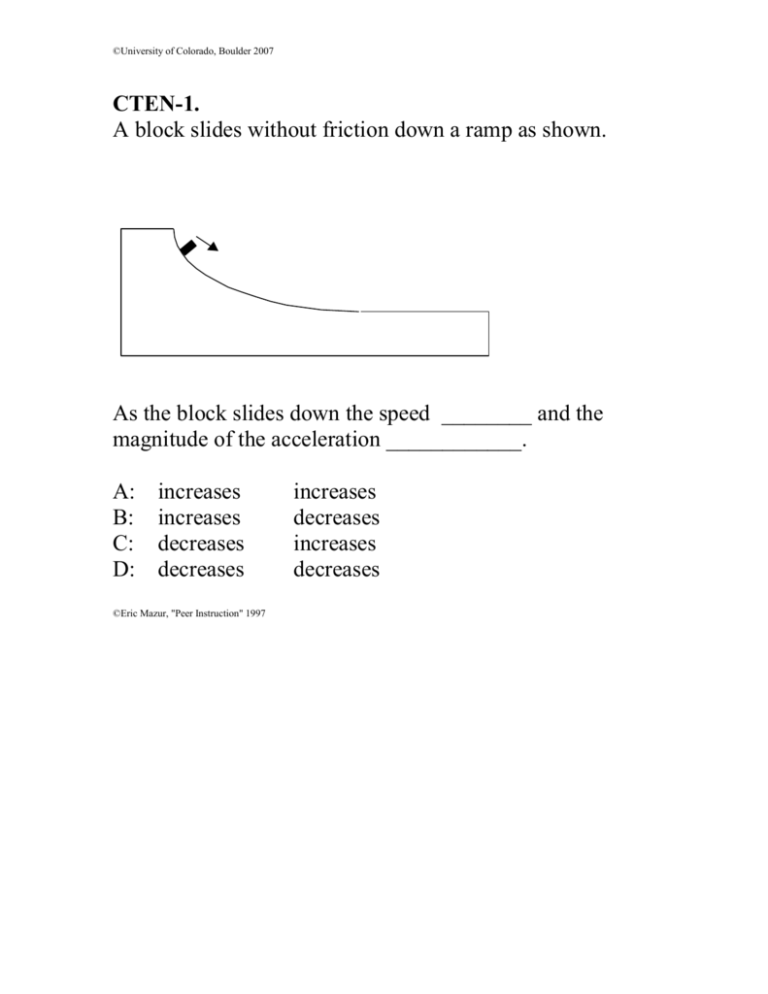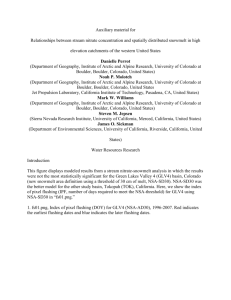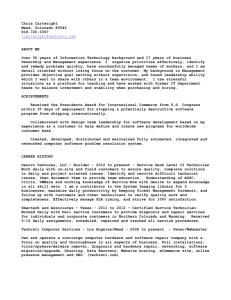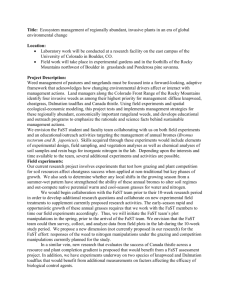7_mechanical_energy
advertisement

©University of Colorado, Boulder 2007 CTEN-1. A block slides without friction down a ramp as shown. As the block slides down the speed ________ and the magnitude of the acceleration ____________. A: B: C: D: increases increases decreases decreases ©Eric Mazur, "Peer Instruction" 1997 increases decreases increases decreases ©University of Colorado, Boulder 2007 CTEN-2. Two marbles, one twice as heavy as the other, are dropped to the ground from the roof of a building. (Assume no air resistance.) Just before hitting the ground, the heavier marble has… A: B: C: D: E: as much kinetic energy as the lighter one. twice as much kinetic energy as the lighter one. half as much kinetic energy as the lighter one. four times as much kinetic energy as the lighter one. impossible to determine. ©Eric Mazur, "Peer Instruction" 1997 ©University of Colorado, Boulder 2007 CTEN-3. A ball is dropped from a tower and attains a speed v at the bottom. To achieve a speed 2v at the bottom, how many times as high must the new tower be? . A: 2 14 D: 4 B: 2 C: 3 E: none of these. ©University of Colorado, Boulder 2007 CTEN-12. A mass m is accelerates downward along a frictionless inclined plane of height, h, and length, d. The directions of the forces are shown on the free-body diagram d N h mg In moving to the bottom of the inclined plane, the work done by the force of gravity is: A) WG = mgd B) WG = mgh C) WG = mgCosθd D) 0 E) None of these In moving to the bottom of the inclined plane, the work done by the Normal force is: A) WN = mgSinθd B) WN = mgh C) WN = mgCosθd D) 0 E) None of these F F m a . What is the correct equation for the x-direction F m a ? x m ax , y y X X y a N mg x A) N mg sin m a C) mg sin m a B) N mgcos ma D) N mgcos 0 ©University of Colorado, Boulder 2007 CTEN-12. A mass m is accelerates downward along a frictionless inclined plane. The magnitudes of the forces on the free-body diagram have not been drawn carefully, but the directions of the forces are correct. N a mg Which statement below must be true? A) N < mg B) N > mg C) N = mg A student chooses a tilted coordinate system as shown, and then proceeds to write down Newton's 2nd Law in the form Fx m a x , Fy m a y . What is the correct equation for the x-direction FX m a X ? y a N mg x A) N mg sin m a B) N mgcos ma C) mg sin m a D) N mgcos 0 E) N mg m a ©University of Colorado, Boulder 2007 CTEN-4. A block initially at rest is allowed to slide down a frictionless ramp and attains a speed v at the bottom. To achieve a speed 2v at the bottom, how many times as high must the new ramp be? . A: 2 14 D: 4 ©Eric Mazur, "Peer Instruction" 1997 B: 2 C: 3 E: none of these. ©University of Colorado, Boulder 2007 CTEN-5 A mass m is at the end of light (massless) rod of length R, the other end of which has a frictionless pivot so the rod can swing in a vertical plane. The rod is initially horizontal and the mass is pushed down with an initial speed vo . What initial kinetic energy is required for the mass to pivot 270o to the vertical position? m R vo 1 mv o2 2 A: mgR B: mg(2R) D: None of these C: mg(3R) ©University of Colorado, Boulder 2007 CTEN-6. A hockey puck slides without friction along a frozen lake toward an ice ramp and plateau as shown. The speed of the puck is 4m/s and the height of the plateau is 1m. Will the puck make it all the way up the ramp? v = 4m/s h = 1m A: Yes B: No C: impossible to determine without knowing the mass of the puck. ©University of Colorado, Boulder 2007 CTEN-7 A small mass, starting at rest, slides without friction down a rail to a loop-de-loop as shown. The maximum height of the loop is the same as the initial height of the mass. Will the ball make it to the top of the loop? A: Yes, the ball will make it to the top of the loop. B: No, the ball will not make it to the top. C: Not enough information to say. ©University of Colorado, Boulder 2007 CT6-1. A mass is oscillating back and forth on a spring as shown. At which position is the magnitude of the acceleration of the mass a maximum? Position 0 is the equilibrium (unstretched) position of the mass. 0 A: 0 B: M C: E M E ©University of Colorado, Boulder 2007 CTEN-8. A spring-loaded dart gun shoots a dart straight up into the air, and the dart reaches a maximum height of 24 m. The same dart is shot straight up a second time from the same gun, but this time the spring is compressed only half as far before firing. How far up does the dart go this time, neglecting friction and assuming an ideal spring? A: 48m D: 6m B: 24m E: 3m C: 12m ©Eric Mazur, "Peer Instruction" 1997 A spring-loaded dart gun shoots a dart straight up into the air, and the dart reaches a maximum height of 24 m. The same gun is reloaded with the spring compressed the same amount, but now the gun is aimed at an angle of 45o to the horizontal. Will the dart reach the same maximum height of 24m? Assume no frictional losses. A: Yes, the dart will reach the same height B: No, the dart will not reach the same height. ©University of Colorado, Boulder 2007 CTEN-9. A cart rolls without friction along a track. The graph of PE vs. position is shown. The total mechanical energy (KE + PE) is 45kJ. 50 E_tot 40 PE(kJ) 30 20 10 0 0 20 40 60 80 100 120 140 160 x(m) To within 5kJ, what is the maximum KE over the stretch of track shown? A: 25kJ B: 7kJ C: 45kJ D: None of these. When the KE is a minimum (over this stretch of track), what is the direction of the acceleration? A: up B: down C: right D: Left E: some other direction (at an angle) or zero. When the KE is max, the direction of the acceleration is: A: up B: down C: right D: Left E: some other direction (at an angle) or zero. ©University of Colorado, Boulder 2007 CTEN-10 A cart rolls without friction along a track. The graph of PE vs. position is shown. The total mechanical energy (KE + PE) is 0 kJ. 0kJ -20kJ -40kJ -60kJ 20m 40m 60m What is the maximum KE of the cart (to within 5kJ)? A: 35kJ B: 48kJ C: 16kJ E: None of these/don't know D:-16kJ Suppose the cart is at position x = 20m, is moving right, and has total energy Etot = -20kJ. Will the cart make it over the hill at x=38m? A: Yes. B: No. ©University of Colorado, Boulder 2007 CTEN-11. A mass slides down a frictionless ramp of height h and hits a carpet with kinetic friction coefficient K = 1.0. Its initial speed is zero. How far does the mass slide along the carpet? h A: h B: Less than h C: more than h ©University of Colorado, Boulder 2007 CTEN-12 A particle moves along the x-axis. Its potential energy U = U(x) is plotted as a function of position x. At which point does the force on the particle have maximum magnitude? U(x) A B C E D x ©University of Colorado, Boulder 2007 CTEN-13 Students are discussing how an object can change its kinetic energy i.e., have a KE. They express the opinions stated below. With which student do you agree? (A): “The Work-Energy Theorem says that the net work done by all the forces on an object gives the change in KE. I think the only way to change the kinetic energy of an object is if there is net work done by the forces on it.” (B): “But, Conservation of Energy says that you can change the KE if the potential energy changes by the opposite amount, so that’s a different way to change KE.” (C): “I think that you could have net work by all the forces AND a change in potential energy that just cancel out, say where the net work by a hand on a book exactly cancels the change in gravitational potential energy, so you can have net work by all the forces and no change in KE.” ©University of Colorado, Boulder 2007 CT7-7. A sports car accelerates from zero to 30mph in 2 seconds. How long does it take to accelerate from zero to 60mph, assuming that the power output of the engine is independent of velocity and neglecting friction and air resistance? A: 4sec B: 6 sec C: 8 sec D: 16 sec E: None of these. ©Eric Mazur, "Peer Instruction" 1997 Answer: 4 times as long = 8 seconds. In this problem, we are assuming that all the engine's energy output goes into the KE of the car (not a realistic assumption). Power = (energy)/(time). If the final speed v is twice as great, then the final KE=(1/2)mv2 is four times as great. Since power P = energy/time is fixed, if the energy is 4 times as great, the time must be four times as great. ©University of Colorado, Boulder 2007 CTCPE-1 A big ball, mass M=10m, speed v, strikes a small ball, mass m, at rest. Could the following occur: The big ball comes to a complete stop and the small ball takes off with speed 10v? 10m v m m 10v M A: Yes, this can occur. B: No, it cannot occur because it would violate momentum conservation C: No, it cannot occur because it would violate conservation of energy. ©University of Colorado, Boulder 2007 CTCPE-2 Two masses, m1 and m2, are approaching each other on a frictionless table and collide. Statement: It is possible that, as a result of the collision, all of the kinetic energy of both masses is converted to heat. A: True B: False







